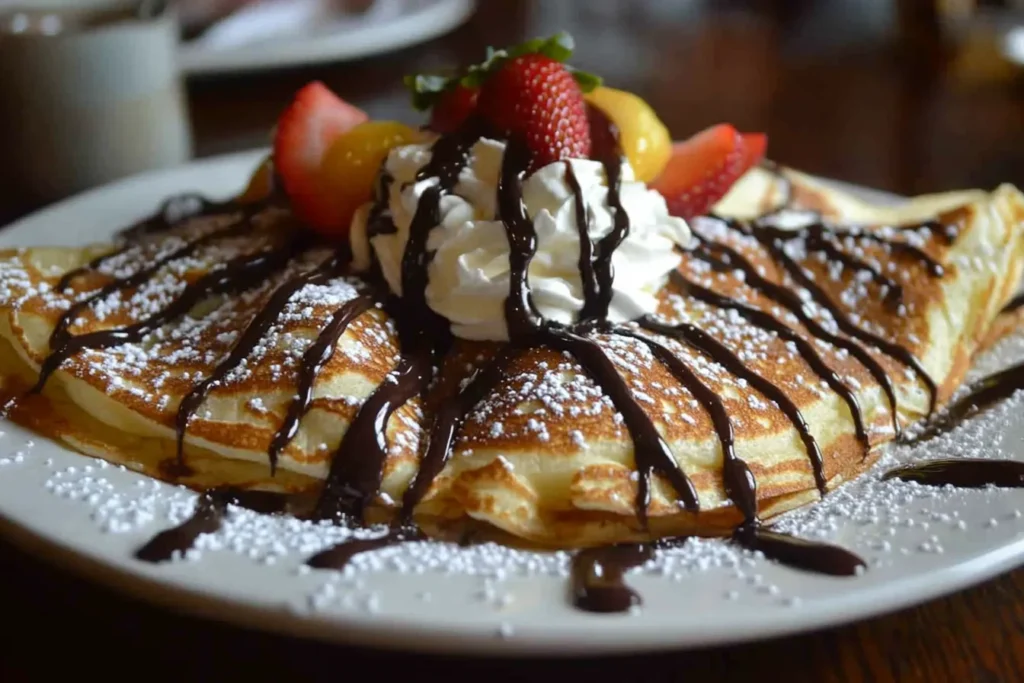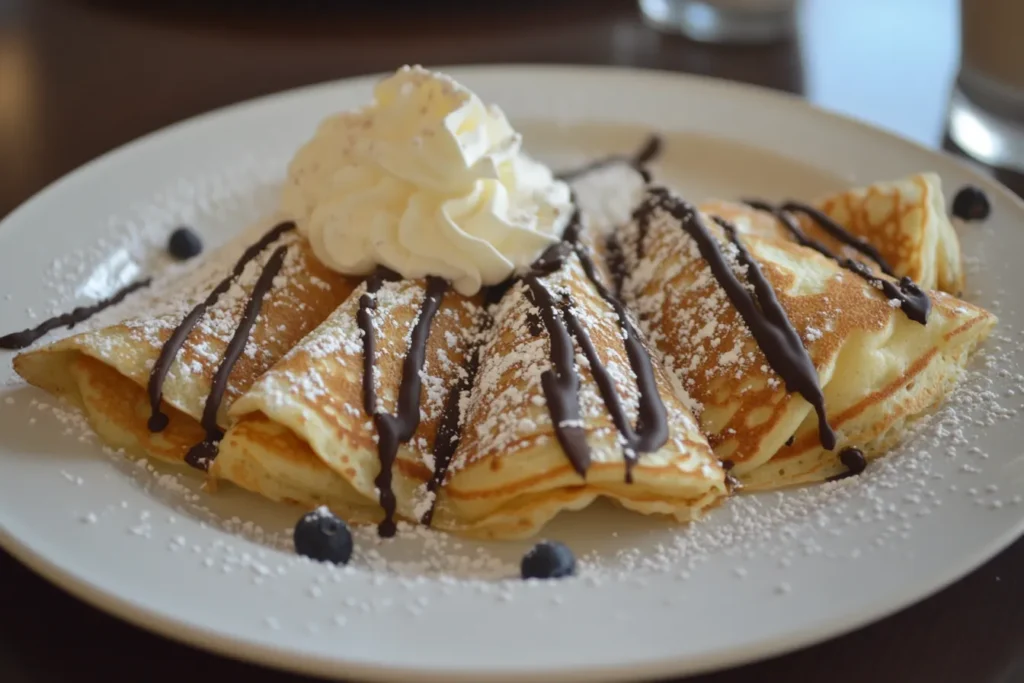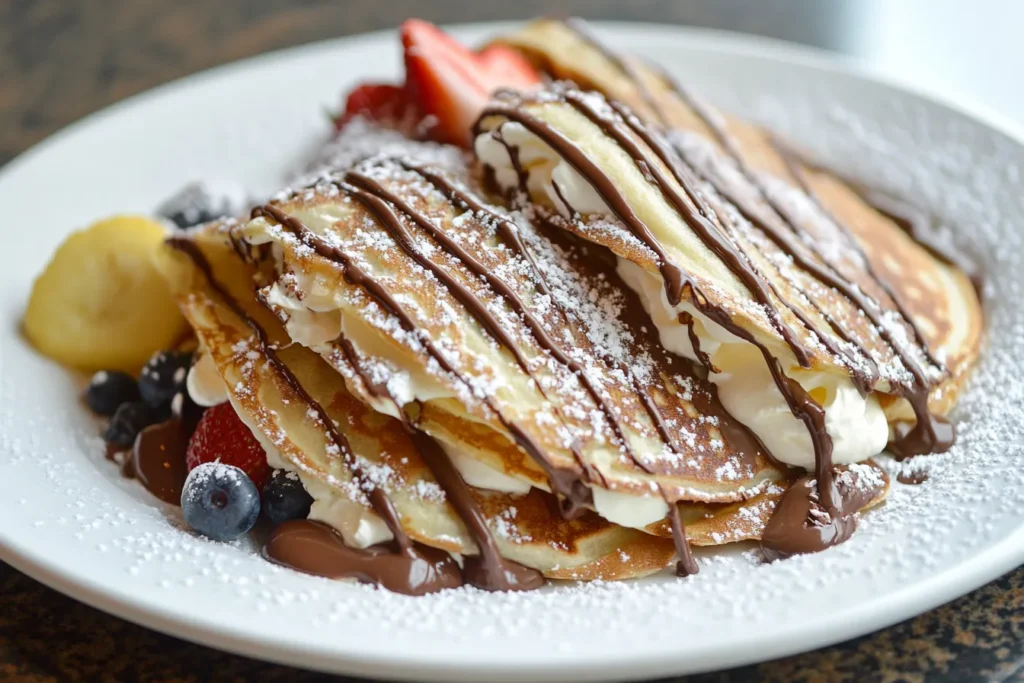Have you ever looked at a crepe and a pancake and wondered, “Aren’t they basically the same thing?” You’re not alone! They may look alike, but they’re worlds apart in texture, taste, and how they’re served. If you’ve ever struggled to decide between the two or thought about swapping one for the other in a recipe, knowing the difference can save you a lot of confusion (and some kitchen mishaps). I used to think crepes were just “fancy pancakes,” but once I discovered their light, paper-thin magic and how versatile they are, it completely changed how I approach breakfast—and dessert! Whether you’re team crepe or team pancake, understanding what sets them apart will make choosing (or making) them so much easier. Let’s settle this crepe vs. pancake debate once and for all!
List Of Contents
Introduction and Overview
1. Introduction to Crepes and Pancakes
Cooks create crepes and pancakes using batter cooked on a flat surface, highlighting a shared foundational similarity. Yet, they differ significantly in texture, ingredients, and cultural roles. Recognizing these differences deepens our appreciation for these versatile dishes and helps you decide which to prepare for your next meal.
- Crepes: Thin, delicate, and flexible, crepes excel at encasing a variety of fillings.
- Pancakes are thick: fluffy, and satisfying, often served in stacks with butter, syrup, or fresh fruit.
2. Historical Background
- Crepes trace their origins to Brittany, France, dating back to the 13th century. Traditionally made with buckwheat flour, they became a symbol of French culinary artistry. Over time, crepes expanded globally, adapted to suit sweet and savory tastes alike.
- Pancakes, by contrast, have an ancient lineage. Variations have been documented in ancient Greece, China, and medieval Europe, each tailored to local ingredients and tastes. In the U.S., they evolved into the buttermilk-rich breakfast staple we know today.
3. Key Ingredients Used
- Crepes: Their batter is typically made from flour, eggs, milk, and butter. The lack of leavening agents ensures the crepe remains flat.
- Pancakes: Pancake batter often includes baking powder or baking soda for a leavening effect, resulting in a fluffy texture. Some variations also add sugar for a hint of sweetness.
4. Preparation Techniques
The consistency of the batter is where the magic happens:
- Crepe batter is thinner, almost watery, allowing it to spread easily across the pan into a delicate sheet.
- Pancake batter is thicker, ensuring it holds its shape when poured onto a hot griddle.
Cooking methods also differ:
- Crepes are cooked quickly in a lightly greased pan and flipped with care to avoid tearing.
- Pancakes require a hot griddle or non-stick surface, and they develop their signature golden color from even heating.
5. Textural Differences
The hallmark of a crepe is its paper-thin, pliable texture, which allows it to be folded, rolled, or stacked. Pancakes, on the other hand, are soft and spongy, offering a satisfying bite and a filling meal. Check out more recipes here.
6. Nutritional Comparison

Crepes and pancakes vary in calorie and nutrient content because of differences in their ingredients and thickness:
- A standard crepe contains fewer calories than a pancake of the same size, primarily due to the absence of leavening agents and added sugar.
- Pancakes, however, are often enriched with butter and syrup, making them more calorie-dense.
7. Visual Appearance
- Crepes are wide, thin, and almost translucent, with a slightly browned surface.
- Pancakes are smaller in diameter but thicker, with a uniform golden-brown hue and a fluffy interior.
8. Popular Serving Styles
- Crepes are versatile: sweet versions include Nutella and strawberries, while savory crepes might feature ham, cheese, or mushrooms.
- Pancakes are classically served with butter, maple syrup, and optional fruit toppings, though savory versions do exist.
9. Global Variations
- Variants of crepes include Russian blini (smaller, often made with buckwheat) and Chinese jianbing (savory street-food crepes).
- Pancakes have their own family of adaptations, such as Dutch pancakes (thinner and larger) and Japanese soufflé pancakes (incredibly thick and airy).
10. Common Misconceptions
- One common myth is that crepes are just “thin pancakes.” In reality, their ingredient ratios and cooking techniques make them distinct.
- Pancakes, while universal in appeal, are not universally prepared the same way—what’s considered a pancake in one country may be a different dish elsewhere.
Cultural and Culinary Perspectives

1. Role in French Cuisine
Crepes hold a prominent place in French culinary traditions, with their origins deeply rooted in the Brittany region. Historically, they were a practical solution to surplus buckwheat flour, eventually evolving into a beloved dish enjoyed across France.
- La Chandeleur (Crepe Day): This February 2nd celebration involves flipping crepes while holding a coin in the other hand, symbolizing prosperity and good fortune. Crepes are also staples in French cafes and markets, where they’re served with an array of fillings.
- Crepes’ versatility in French cuisine has inspired dishes like galettes, made from buckwheat flour and served with savory toppings like ham, cheese, or eggs.
2. Role in American Breakfast Culture
In contrast, pancakes are deeply woven into American breakfast traditions. Often paired with bacon, eggs, or sausage, pancakes are celebrated for their comforting simplicity.
- The advent of pancake mixes in the early 20th century made pancakes even more accessible. Brands like Aunt Jemima (now Pearl Milling Company) popularized quick-prep mixes that became household staples.
- Pancake houses, such as IHOP, have solidified their status as a quintessential part of the American diner experience.
3. Sweet vs. Savory Options
- Crepes: Their neutral batter is the perfect canvas for both sweet and savory creations. Sweet crepes often feature fruits, chocolate spreads, or whipped cream, while savory crepes can include ingredients like smoked salmon, spinach, or béchamel sauce.
- Pancakes: Traditionally served as a sweet dish, pancakes are often topped with maple syrup, honey, or powdered sugar. However, savory variations—like potato pancakes or cornmeal pancakes—add a creative twist.
4. Cooking Techniques Explained
- Crepes are typically made using a specialized crepe pan or a flat skillet. Some chefs use a crepe spreader to achieve an even, thin layer of batter.
- Pancakes require a hot griddle or skillet, with the batter scooped in circles to create even shapes. The presence of bubbles on the surface signals that it’s time to flip.
Key tip: Resting the batter before cooking—whether for crepes or pancakes—helps improve the texture and flavor. For crepes, resting allows gluten to relax, while for pancakes, it helps activate the leavening agents.
5. Folding and Plating Techniques
- You can fold crepes into triangles, roll them like burritos, or stack them into a layered cake. You often drizzle sauce or dust powdered sugar for presentation.
- People stack pancakes high and pour toppings generously over the top, creating a visually indulgent plate.
6. Pairing Suggestions
- Crepes: Pair sweet crepes with coffee or champagne for an elegant touch. Savory crepes go well with cider, dry white wine, or herbal teas.
- Pancakes: Classic pairings include orange juice, coffee, or milk. For a hearty meal, add a side of crispy bacon or scrambled eggs.
7. Family and Cultural Traditions
- In many American households, families cherish weekend pancake breakfasts as rituals. Kids pour and flip pancakes, creating lasting memories.
- In France and beyond, people tie crepes to celebrations and gatherings, serving them at festivals, markets, and family dinners.
8. Popular Variations Worldwide
- In Brittany, cooks make savory crepes called galettes with buckwheat flour and fill them with hearty ingredients like cheese and ham.
- In Russia, people prepare small crepe-like pancakes called blini and often top them with sour cream, smoked salmon, or caviar.
- Japanese Soufflé Pancakes: These incredibly fluffy pancakes have gained international fame for their unique texture and presentation.
9. Influence of Modern Trends
- Gluten-Free and Vegan Options: Both crepes and pancakes have adapted to modern dietary needs. Substituting wheat flour with almond or oat flour and replacing eggs with flaxseed allows everyone to enjoy these dishes.
- Fusion Recipes: Innovative chefs are blending crepes and pancakes into hybrid dishes, like crepe cakes layered with pancake batter or savory pancakes rolled and stuffed like crepes.
10. Tools and Equipment
- For crepes:
- Crepe pans: Lightweight with low edges for easy flipping.
- Crepe spreaders: Tools that help create the perfect thin layer of batter.
- For pancakes:
- Griddles: Provide an even cooking surface for multiple pancakes at once.
- Ring molds: Help shape uniformly thick pancakes.
Crepes and pancakes may differ in origin, texture, and cultural significance, but they both bring joy to the table. Whether you prefer the refined elegance of crepes or the comforting simplicity of pancakes, there’s no denying their universal appeal.
Key Differences and Final Thoughts

1. Batter and Texture Differences
The key to distinguishing crepes from pancakes lies in their batter composition and texture.
- Crepes: Their batter contains fewer ingredients and has a thinner consistency. With no leavening agents, crepes remain flat, creating a smooth, elastic surface perfect for folding or rolling.
- Pancakes: Baking powder or baking soda in pancake batter leads to a fluffier texture. Pancakes are thicker, with a soft crumb that absorbs syrup and butter beautifully.
The ratio of eggs to flour in crepes is higher, lending them a more custard-like quality, while pancakes focus on achieving a bread-like, hearty consistency.
2. Sweetness Levels
The sweetness profile of these dishes further differentiates them:
- Pancakes are often slightly sweetened in the batter itself, enhancing their dessert-like appeal even before toppings.
- Crepes, on the other hand, are neutral, making them equally suited to savory or sweet applications.
This neutrality allows crepes to accommodate fillings ranging from whipped cream and berries to smoked salmon and ricotta.
3. Cooking Temperatures
Maintaining proper temperature is essential for successful cooking:
- Crepes: Cooked over medium heat, requiring quick and even spreading to achieve their signature thinness.
- Pancakes: Prepared on a hot griddle, with a slightly lower temperature to ensure they cook through without burning.
The visual cues are also different. Crepes cook in a single layer with no flipping required until lightly browned. Pancakes bubble on the surface before flipping, a sign that their centers are setting.
4. Flavor Profiles
- Crepes serve as a blank slate, absorbing the flavors of their fillings or toppings. A simple crepe with lemon and sugar highlights its delicate taste.
- Pancakes have a more robust flavor, often complemented by hints of vanilla or buttermilk in the batter.
While pancakes are typically eaten as is, crepes rely on their fillings to define the dish.
5. Regional Preferences
Cultural influences significantly shape the popularity of crepes and pancakes:
- Europe: Crepes dominate as a versatile meal option. Countries like France, Sweden, and Russia serve crepes or crepe-like dishes as part of daily meals or special celebrations.
- North America: Pancakes reign supreme as a breakfast icon, with countless diners and chains specializing in tall stacks served with maple syrup.
In Asia, variants like Chinese jianbing and Japanese soufflé pancakes illustrate how these dishes have been adapted to local tastes.
6. Meal Timing and Usage
Meal timing reflects another point of divergence:
- Crepes are an all-day affair, served as breakfast, lunch, dinner, or dessert. Savory crepes filled with ham and cheese make for a satisfying main course, while sweet versions are popular as snacks.
- Pancakes are predominantly a breakfast item, though certain variations, like potato pancakes, find their way into other meals.
7. Ease of Preparation
Crepes demand precision:
- Thin batter and rapid swirling techniques can challenge even experienced cooks.
- Specialized tools, such as crepe spreaders or crepe makers, simplify the process but are not essential.
Pancakes are more forgiving:
- Their thicker batter and straightforward cooking process make them beginner-friendly.
- Minimal tools are needed—just a mixing bowl, spatula, and griddle.
8. Cost Effectiveness
The cost of ingredients and preparation can vary:
- Crepes: Require fewer, simpler ingredients, but tools like crepe pans can add to the expense if not already owned.
- Pancakes: Slightly pricier due to leavening agents and optional sweeteners, but their equipment requirements are more basic.
For large groups, pancakes may be the more practical option due to their speed and ease of preparation.
9. Modern Fusion Recipes
Fusion cuisine has blended crepes and pancakes into exciting hybrids:
- Crepe cakes: Layered stacks of crepes with cream fillings offer a dessert that’s visually stunning and delicious.
- Savory pancake wraps: Thick pancakes rolled around savory fillings, combining the best of both worlds.
- Stuffed pancakes: Borrowing from crepes, these pancakes enclose fillings such as Nutella or cream cheese, creating a portable snack.
Restaurants increasingly feature inventive dishes like crepe burritos or pancake sandwiches, showcasing their adaptability to modern tastes.
10. Conclusion: The Unique Appeal of Each
Both crepes and pancakes offer their own charms:
- Crepes are the epitome of culinary elegance, perfect for special occasions or creative meals.
- Pancakes provide comfort and nostalgia, ideal for leisurely breakfasts with family.
Whether you prefer the delicate sophistication of crepes or the hearty indulgence of pancakes, both deserve a place in your kitchen. Exploring their differences only deepens our appreciation for these timeless dishes.
FAQs
- Are crepes healthier than pancakes?
Crepes are often lower in calories due to their thin nature and lack of sugar or leavening agents. - Can pancake batter be used to make crepes?
Pancake batter is too thick and fluffy; you’d need to thin it out for crepes. - What’s the best flour for crepes?
All-purpose flour works well, but buckwheat flour is traditional for savory crepes. - Can crepes and pancakes be made gluten-free?
Yes, alternative flours like almond, oat, or rice flour work for both. - Why do pancakes sometimes turn out rubbery?
Overmixing the batter develops gluten, leading to a denser texture. - Do crepes need special pans?
While a crepe pan helps, any flat, non-stick skillet will do. - What’s the difference between crepes and blini?
Blini are smaller, thicker, and often made with yeast, while crepes are larger and thinner. - How long can crepe or pancake batter sit?
Crepe batter can rest for up to 24 hours, while pancake batter is best used immediately or within 1 hour. - What’s the ideal temperature for cooking pancakes?
Medium heat ensures even cooking without burning. - Can crepes be frozen?
Yes, stack them with parchment paper in between and freeze in airtight bags.
